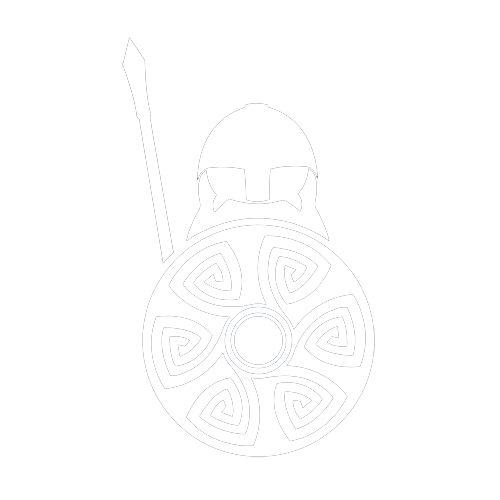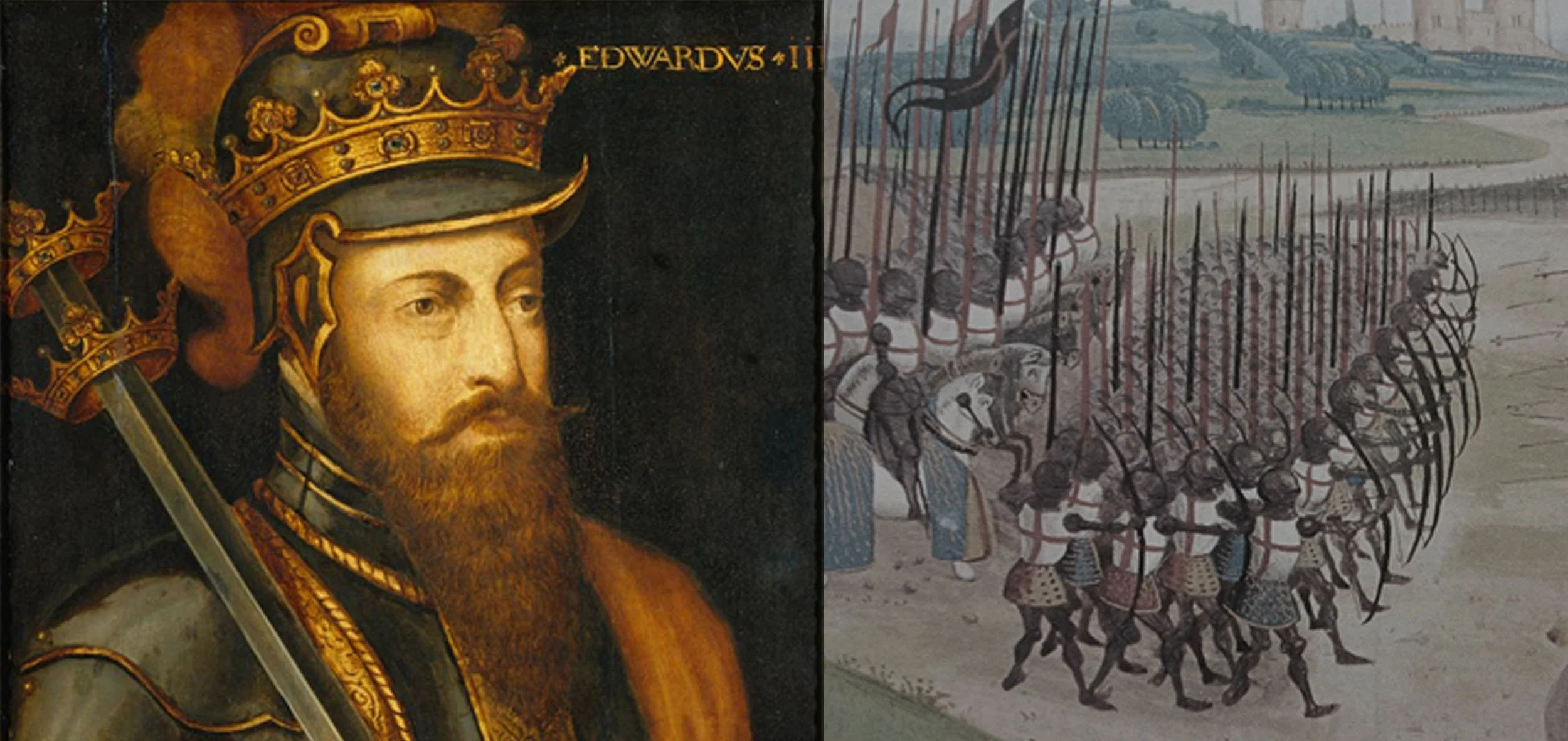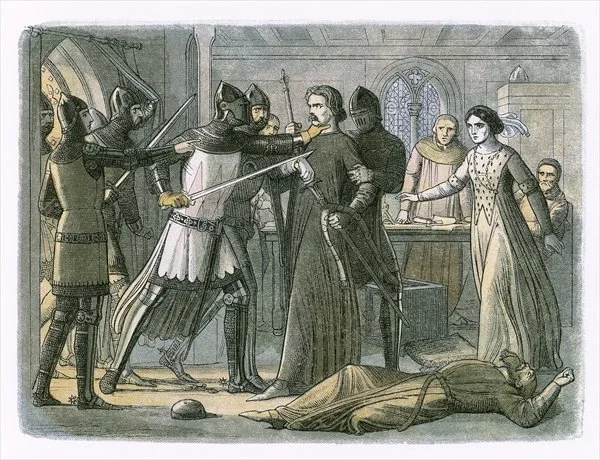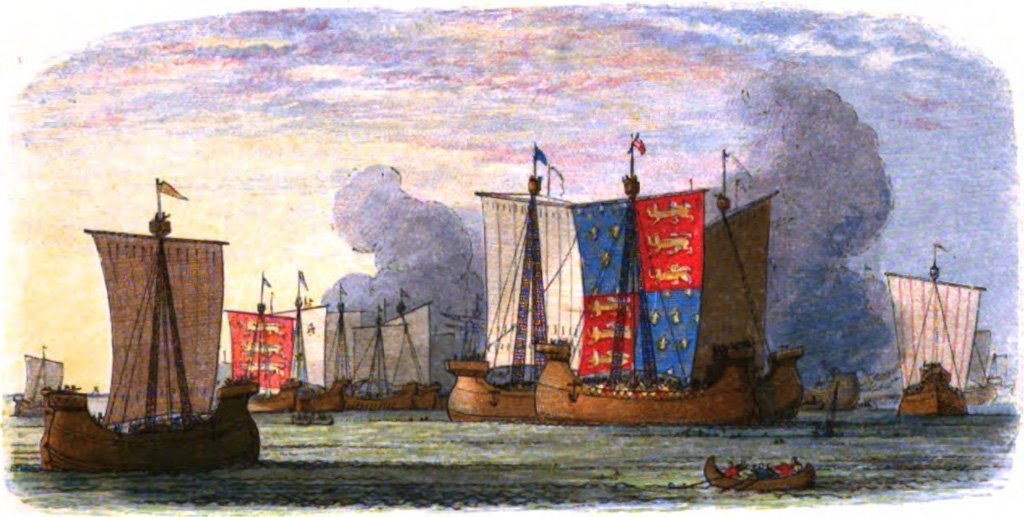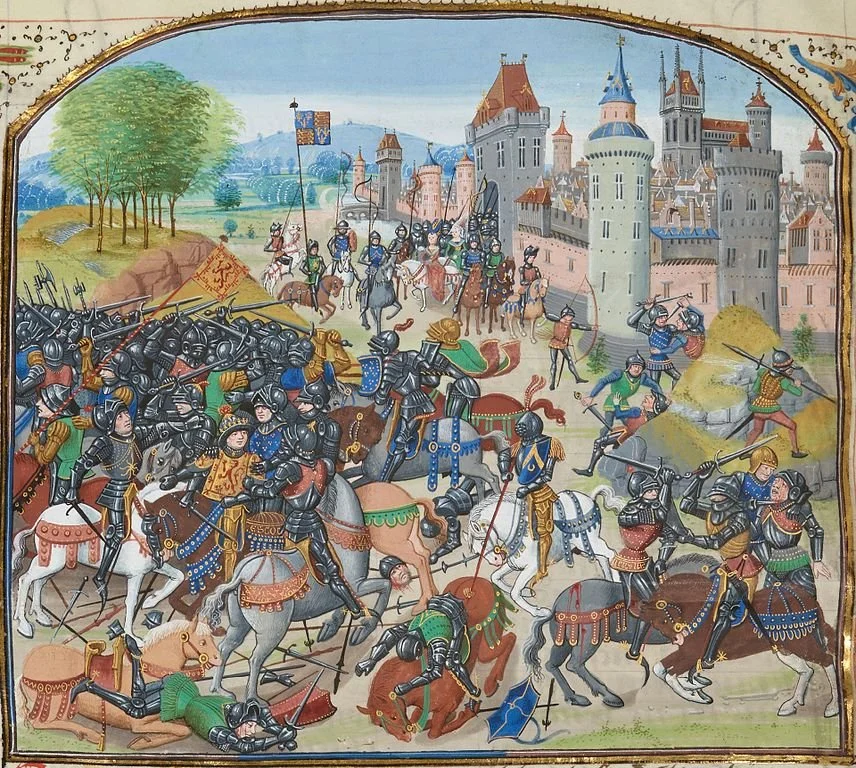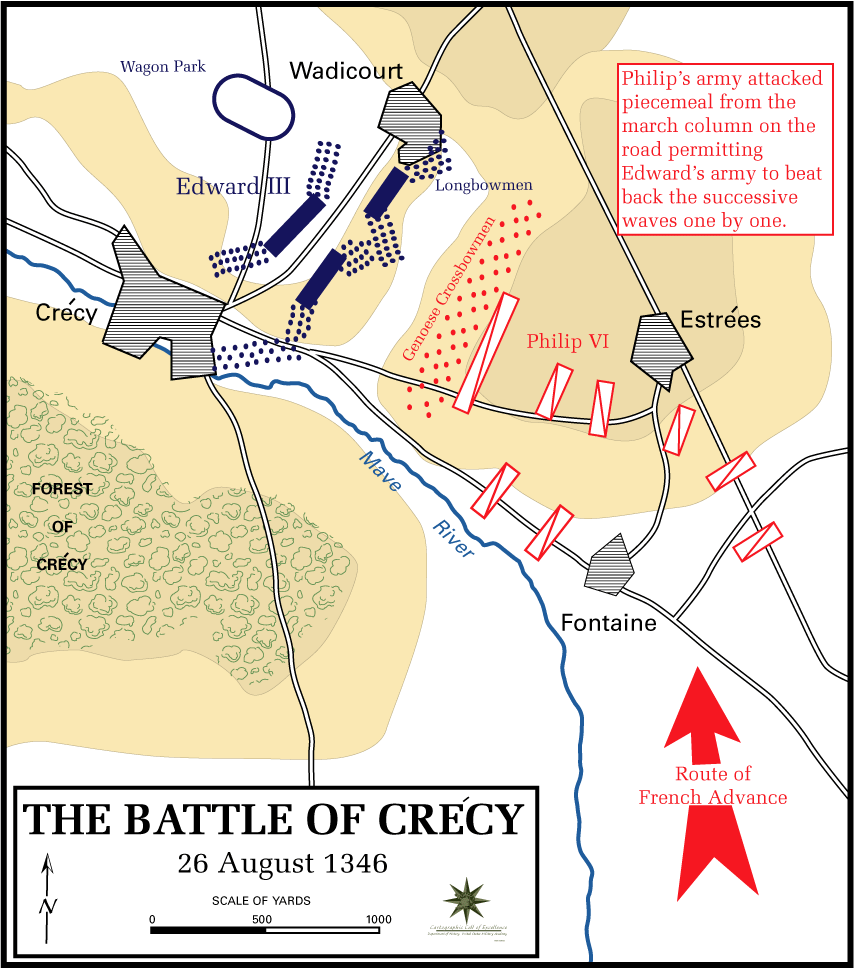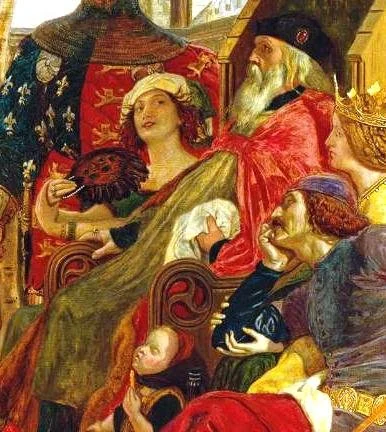King Edward III was born at Windsor Castle on 13 November 1312. He was the first son of Edward II and Isabella of France. Edward acceded his father at the tender age of 14, and went on to become one of England's most popular and successful kings.
The People's favourite, King Edward III was flamboyant, generous and a victorious warrior king. He regained lands in France, united his court and his barons' favour through Parliament, and banished the demons from his father's reign. Yet his life ended with his heir already dead, his lands lost and his popularity in tatters.
| Born | 13 November 1312, Windsor Castle |
| Parents | King Edward II and Isabella of France |
| Married | Philippa of Hainault, daughter of William I, Count of Hainault and Joan of Valois |
| Children | 13, inc Edward the Black Prince and John of Gaunt |
| Died | 21 June 1377, Sheen Palace (64) |
| Reign | 1327 - 1377 (50) |
| Crowned | 1 February 1327, Westminster Abbey (14) |
| Predecessor | Edward II (father) |
| Successor | Richard II (grandson) |
| House | Plantagenet |
Life Events of King Edward III
1312
On 13 November, Edward III is born at Windsor Castle to King Edward II and Isabella of France.
1327
On 1 February, Edward is crowned King Edward III of England, at Westminster Abbey, aged just 14.
1328
On 24 January, Edward II marries Philippa of Hainault, daughter of William I, Count of Hainault.
1330
Edward III executes a successful coup against Roger Mortimer, who had become too powerful. Mortimer is arrested and executed, and Edward III asserts his authority as the true ruler of England.
1337
King Edward III lays claim to the French crown, triggering the start of the Hundred Years' War between England and France. This conflict would last intermittently for over a century.
1340
Edward III departs for France with 400 ships and encounters French ships. The Battle of Sluys begins on 24 June, Edward is victorious.
1346
On 26 August, Edward III defeats Philippe VI of France in a decisive victory at the Battle of Crecy. The battle showcases the effectiveness of the English longbow and establishes Edward III as a skilled military leader.
1346
On 4 September, King Edward III besieges Calais, which would go on for a year, finally falling on 4 August 1347.
1346
On 17 October 1346, King Edward III defeats the Scots at the Battle of Neville's Cross. King David II of Scotland is captured and imprisoned for 11 years until his 100,000 mark ransom is paid.
1348
The Black Death, a devastating pandemic, sweeps across Europe, including England. The plague causes significant loss of life and has a profound social and economic impact on the country.
1348
In August, King Edward III founds the Noble Order of the Garter, which is now the oldest and most prestigious order in Britain.
1356
On 19 September, Edward III's eldest son and heir, Edward the Black Prince, achieves a major victory against the French at the Battle of Poitiers. The battle results in the capture of the French King John II.
1360
On 8 May, the Treaty of Bretigny is drafted. It states that Edward obtains Gascony, Ponthieu and Calais without paying homage. But Edward III would give up lands in the north of France (apart from Calais) and renounce his claim to the French throne. The treaty is later ratified on 24 October and renamed the Treaty of Calais.
1369
On 15 August, Queen Philippa dies and is interred at Westminster Abbey.
1376
On 8 June, Edward III's son and heir, Edward the Black Prince dies from dysentery at Westminster Palace. He is buried at Canterbury Cathedral.
1377
The Good Parliament is called, where the Commons voices their outrage at the years of crippling taxes, corruption and the level of misgovernment. The Bad Parliament follows in 1377.
1377
On 21 June, King Edward III dies of a fatal stroke at Sheen Palace in Richmond, age 64. He is buried at Westminster Abbey on 5 July. Edwards grandson, Richard, accedes him at the age of 10.
Interesting Facts About King Edward III
Long Reign
King Edward III's reign lasted for 50 years, from 1327 until his death in 1377. This makes him one of the longest-reigning monarchs in English history.Start of the Hundred Years' War
Edward III's claim to the French crown and his subsequent military campaigns against France marked the beginning of the Hundred Years' War, a prolonged conflict between England and France.Battle of Crécy
Edward III achieved a significant victory over the French at the Battle of Crécy in 1346. The battle demonstrated the effectiveness of the English longbow and showcased Edward III's military leadership.Order of the Garter
Edward III is credited with founding the Order of the Garter, one of the most prestigious orders of chivalry in England. It is said that the order's motto, ‘Honi soit qui mal y pense’ (Shame on him who thinks evil of it), originated from an incident involving Edward III and a lady's garter.The Black Prince
Edward III's eldest son, Edward, Prince of Wales, was known as the Black Prince. He gained fame for his military exploits and played a crucial role in several victories during the Hundred Years' War.Black Death
Edward III's reign coincided with the devastating outbreak of the Black Death, a deadly pandemic that killed a significant portion of the population in England and Europe. The plague had a profound impact on society, labour and the economy during his rule.Decline
Towards the end of his reign, Edward III's power and influence waned. He became less involved in governing, and political factions vied for control, leading to instability during the latter part of his reign.
Battles Fought By King Edward III
Battle of Halidon Hill
In 1333, this battle took place during the Second War of Scottish Independence. Edward III supported his ally, Edward Balliol, in his claim to the Scottish throne. The English forces, led by Edward III, achieved a decisive victory over the Scots.Battle of Sluys
On 24 June 1340, this naval battle occurred during the early stages of the Hundred Years' War between England and France. Edward III's fleet defeated a much larger French fleet, establishing English naval dominance in the English Channel.Battle of Crécy
On 26 August 1346, One of the most significant battles of the Hundred Years' War, the Battle of Crécy saw Edward III's English forces face the French army. The English, aided by the longbow, achieved a resounding victory, showcasing their military prowess.Battle of Calais
In September 1346, following the Battle of Crécy, Edward III laid siege to the city of Calais. The siege lasted for almost a year, during which the English forces successfully held their position, eventually leading to the surrender of Calais to the English.Battle of Neville's Cross
In October 1346, while Edward III was campaigning in France, his queen, Philippa of Hainault, defended England against a Scottish invasion. The Battle of Neville's Cross resulted in a decisive victory for the English forces led by Philippa and her son, Edward the Black Prince.Battle of Poitiers
On 19 September 1356, Edward III's eldest son, Edward the Black Prince, achieved a significant victory over the French forces at the Battle of Poitiers. The French King John II was captured, further enhancing Edward III's military reputation.Battle of La Rochelle
On 22 June 1372, this naval battle took place during the later stages of the Hundred Years' War. Edward III's fleet engaged the French fleet near La Rochelle, resulting in a decisive defeat for the English forces.
FAQs About the King
How long did King Edward III reign?
King Edward III reigned for 50 years, from 1327 until his death in 1377. His reign is one of the longest in English history.What was the Hundred Years' War and why did it start?
The Hundred Years' War was a series of conflicts between England and France that lasted intermittently from 1337 to 1453. It began when Edward III of England laid claim to the French crown, which he believed was his by right.What was King Edward III's role in the Hundred Years' War?
King Edward III played a significant role in the early stages of the Hundred Years' War. He led successful military campaigns in France, including the famous Battle of Crécy in 1346, where the English achieved a decisive victory.What was the significance of the Battle of Crécy?
The Battle of Crécy, fought on 26 August 1346, was a major victory for Edward III's English forces against the French. It showcased the effectiveness of the English longbow and established Edward III as a skilled military leader.What is the Order of the Garter?
The Order of the Garter is one of the oldest and most prestigious orders of chivalry in England. It was founded by King Edward III, and he is credited with establishing the order, which continues to this day.What impact did the Black Death have on King Edward III's reign?
The Black Death, a devastating pandemic that struck Europe in the 14th century, had a significant impact on Edward III's reign. The plague caused immense loss of life and had far-reaching social and economic consequences.What was the significance of Edward III's death?
King Edward III's death on 21 June 1377, marked the end of the direct male line of the Plantagenet dynasty. He was succeeded by his grandson, Richard II, which eventually led to power struggles and the Wars of the Roses in the 15th century.
Further Reading
King Edward III Heir Apparent
At only a few days old, Edward was bestowed the title Earl of Chester by his father, King Edward II. This was a significant title usually granted to the heir apparent since 1301. From the 14th century, the title has only been given in conjunction with the Prince of Wales. During the early years of his childhood, attempts were made to find a suitable bride for the future king. However, initial proposals with the Houses of Hainault and Valois among others failed.
In 1325, Edward was given further titles; the Duke of Aquitaine and Count of Ponthieu. But these titles were only created because his father refused to travel to France himself! Charles IV had demanded Edward II to pay homage for the duchy of Aquitaine. To settle the dispute, Edward's mother, Isabella, was sent to France to negotiate peace with her brother, Charles.
The Engagement and the Coup
Isabella's negotiations were successful, and peace was restored. But only on the condition that young Edward travels to France to pay homage, in place of his father. In September 1325, Edward boarded a ship and sailed to France.
While in France, Isabella met with her lover, Roger Mortimer, who himself has been exiled. He had escaped from the Tower of London, and fled to France 2 years earlier. Together they conspired to overthrow Edward II, but needed an army. Isabella arranged the marriage of her son Edward to Philippa of Hainault, giving her the military might she needed.
In September 1326, Isabella and Mortimer arrived in England with an army. Gathering support on route to London, Edward II fled, and was eventually captured, imprisoned and then deposed.
King Edward III is Crowned and Married
Young Edward acceded to the throne of England on 25 January 1327. But Isabella had to move fast, some were not too pleased that a 14 year old boy was to replace a deposed king, by a French woman, and her lover!
So a week later, on 1 February, Edward was crowned King Edward III of England, at Westminster Abbey. However, it was clear to all, that Edward was to be king by name only. England would be ruled by Isabella and Roger Mortimer, until Edward came of age 3 years later.
Just under a year since his accession, King Edward III married his betrothed, Philippa of Hainault, on 24 January 1328 in York. They would remain married for over 40 years, and produce 13 children, including the famous Edward of Woodstock, the Black Prince.
King Edward III Shows Early Promise
Mortimer seized his opportunity as effective ruler for England. Enriching himself with the title Earl of March, Mortimer soon became despised by most. He was not officially Regent, but tried to act like one. He took over lordships from the Despensers and the Earl of Arundel, and squandered the governments treasury. Lancastrian opposition became outraged by his lack of responsible government. King Edward III did little to help.
Henry, Earl of Lancaster made an attempt to overthrow Mortimer, which failed. But then in 1330, Mortimer ordered the execution of Edward's uncle for planning a rebellion, a fateful mistake. This was the final straw for Edward, for he had come of age and asserted himself and took back power. King Edward III ordered Mortimer's arrest, and he was put on trial for treason, and then executed. Isabella was treated more leniently, and Edward mercifully banished her to Norfolk, where she lived the rest of her days.
King Edward III Unites Parliament
During his father's reign, Parliament was torn by rivalries and divisions. To heal these, King Edward III surrendered some of his power, and ensured his role in Parliament was consultative. He also split Parliament into 2 houses, the Lords and the Commons. This drew parallels with the principles of Magna Carta, and the barons liked it. After all, Edward knew he would have to fund some likely wars abroad, and only Parliament could approve the costs!
The Treaty of Northampton
In 1328, King Edward III was obliged to sign the Treaty of Northampton by Isabella and Mortimer. This treaty guaranteed Scottish independence. However, the present fear of a Scottish/French alliance on the horizon, and Robert the Bruce now dead, Edward saw an opportunity.
David II of Scotland acceded Robert the Bruce in 1329, at the age of 5! But King Edward III favoured the other claimant Edward Balliol, just like this father did with John Balliol. So, in 1332, Edward backed an attempt by Balliol to seize the Scottish throne.
The Battle of Halidon Hill
In 1333, King Edward III marched north, to reinforce Balliol's army at Berwick-upon-Tweed. Edward made an agreement with the town that it would surrender, if the Scottish could not relieve them by July. The bulk of the Scottish army had already invaded England, and were heading towards Bamburgh Castle, where Edward's wife Philippa was staying. But Edward remained in Berwick, assured by the defences that Bamburgh boasted.
Halidon Hill © Lisa Jarvis (cc-by-sa/2.0)
However, Edward had learned that a small band of Scottish soldiers had infiltrated Berwick and the town withdrew their surrender. This infuriated Edward, who began hanging hostages at 2 per day until the town re-surrendered.
On the day before the surrender date, the larger Scottish army of King David II had gathered just north of Halidon Hill, at the Witches’ Knowe. The Scots charged towards the English position, but got caught up in boggy land. King Edward III made use of this archers, and inflicted heavy casualties on the impeded Scots. At this point, the English launched their attack, and the Scottish were defeated. David II fled to France.
Halidon Hill was King Edward III's first battle, and it was a decisive victory. The plan to use archers, and in particular the longbow, would become the strategy that Edward would go on to use against France, with deadly consequences.
The Hundred Years War Begins
The ongoing battle with Scotland was not Edward's main priority. He had his eyes on France. In 1328, Charles IV of France died without an heir. King Edward III was Charles' nephew, and therefore had a legitimate claim to the French throne. But the French Parliament chose Charles' cousin, Philippe VI, to be the new king of France.
In 1331, Edward travelled to France to pay homage to the new king, for his lands in Gascony. After all, these lands supplied England with wine! However, in 1334, Philippe VI sheltered David II of Scotland, reinforcing their Auld Alliance, and relations between England and France soured.
So, King Edward III decided to make a claim for the French throne. In retaliation, Philippe VI invaded Gascony in 1337 and sent some ships to attack coastal ports in England. Gascony was later reclaimed by the Earl of Derby, but things quietened down while Edward gathered his war chest. However, the Hundred Years War (actually 116 years) had begun.
King Edward III Declares Himself King of France
In 1340, King Edward III formally declared himself King of France, and added the Fleur-de-Lys to his arms. This title remained with the British monarchy up until 1801. This prompted a stark response from the French.
The Battle of Sluys
King Philippe VI of France anchored a fleet of around 200 French and Genoese ships at Sluys, off the coast of Flanders. King Edward III set sail with a larger fleet of around 400 ships, to assert his claim to the French throne.
The two flotillas met head on in June 1340. As sea battles were fought on ship decks, the English once again had the advantage of the longbow. These proved to be quicker and more accurate than the Genoese crossbows, and after a day of fighting, the French fleet were destroyed. The French chose not to attempt to invade England again, although there would be more small scale raids along the English coast. But the rest of the Hundred Years War would be fought in France.
“The numbers of French dead were such, it was claimed, that the fish could have learned French!”
The Battle of Neville's Cross
The French and the Scots had renewed their Auld Alliance, which concerned King Edward III. While the king was off pressing his claim to the French throne, Philippe VI of France called upon David II of Scotland to invade England, confirming Edward's fears. Fortunately Edward had chosen to leave a fighting force in the north, before setting off.
“I beg you, I implore you … Do for me what I would willingly do for you in such a crisis and do it as quickly … as you are able. ”
David II marched south to Durham, to lay siege to the city. The Scots were confidant that the north would be free from English soldiers, as most were fighting in France. However, William Zouche, Archbishop of York and a Warden of the Marches, Henry Percy and Lord Ralph Neville led English troops to intervene.
On 17 October 1346, the two armies met at Neville's Cross, just to the west of Durham. Both armies had split into their formations, and advanced. The English were formed of men-at-arms and archers, with their formidable longbows. The first Scottish advance was met with arrows, and such was the devastation, that the other Scottish formations fled.
The English pursued them, and despite having greater numbers, the Scots were routed. The longbow was again used to devastating effect, killing thousands and demoralising the rest. The men-at-arms fought ferociously too. David II was injured, and subsequently captured and brought down to London. There he would spend the next 11 years imprisoned, until his 100,000 mark ransom was paid. Other English nobles ransomed off their own Scottish captives, much to the anger of Edward.
The Battle of Crecy
Despite this Scottish attempt to help France by way of distraction, King Edward III continued his campaign in France. On 26 August 1346, one of the most famous battles of the Hundred Years War took place. The English were rampaging through northern France (chevauchée), when they were confronted by Philippe VI, and a far larger army, at Crecy.
A skirmish between English archers and French/Genoese crossbowmen ensued. The English archers, with their superior longbows, inflicted huge casualties. The Genoese, who usually carry a Pavise (but had left them behind), were extremely vulnerable while they reloaded their crossbows.
At this point, the French launched a number heavy cavalry charges. French nobleman thundering into battle upon enormous destriers, were thwarted by fleeing crossbowmen, uneven ground and small ditches dug by the English. Volley after volley from the English longbows, soon devastated the advancing cavalry. The ones that made it, were cut down by the unmounted men-at-arms, in horrific hand-to-hand combat, led by Edward's son and heir, Edward the Black Prince.
King Edward III firmly believed in chivalry, and in his eyes, knights should be captured and ransomed. The treatment of the French noblemen, who were brutally cut down and killed, was strongly condemned by the king. Those that died included King John of Bohemia, who was blind. His wish was to land a single blow in battle, which would ultimately be his last.
At the end of the battle, the Black Prince saw the blind king on the ground, surrounded by his household guard. While he was paying his respects, he noticed a white feathered emblem with the motto "Ich Dien" (I serve) on the king. He liked it so much, that he adopted it as his own. The three white feathers in a crown, and the motto, has been the emblem of the Prince of Wales ever since.
Calais is Captured
A month after the extraordinary battle at Crecy, King Edward III marched north to Calais. He needed a port to provide reinforcements and supplies from England, and Calais was strategically excellent.
On 4 September 1346, Edward besieged the town. Calais was surrounded by huge walls, and the moated citadel was well protected. The siege lasted for nearly a year, when the Calais finally fell on 4 August 1347. The population were on the brink of starvation, with both food and water supplies cut off. Edward demanded six of the town's leaders to be executed, in order to let the rest of the inhabitants live. But before the executions could take place, Queen Philippa pleaded for mercy, and Edward chose to oblige and allow the leaders to live.
The Black Death
The Hundred Years War was now on hold, while a truce was agreed. King Edward III needed money, and so he returned to England in October 1347. But money wasn't the only concern. In 1348, a deadly pestilence had arrived from Europe, and initially hit Bristol. People were dying in vast numbers, some within a few hours, others within two days. Many believed it to be the Wrath of God, as the sheer number of deaths were horrifying. The Black Death, or Plague had arrived.
The creeping pestilence spread quickly over Britain, inflicting death on all classes of society. Within two years, a third of England's population were dead. The living could no longer bury all the dead, as the numbers were too great. In Europe, between 30-60% of the entire population were killed.
By 1350, the Plague had subsided for the time being, but would return again many times throughout the century, and then the Great Plague of 1665. The economic consequences were profound. Peasants' numbers were decimated, and those that lived could charge more for their work. Their demand was so great, that their place in the social hierarchy improved. Soon they would begin to stand up for their working rights, something unheard of before.
The Noble Order of the Garter
King Edward III was a chivalrous man, who believed in honour. He encouraged the Code of Chivalry, which went beyond the rules of battle. Some of the rules of the code include: respect and defend the weak, respect God and his church, respect the honour of women, love your country and do not fear your enemy!
In August 1348, in honour of chivalry, Edward founded the Noble Order of the Garter, which is now the oldest and most prestigious order in Britain. There were (and are) never more than 26 'Companions' (members), of which Edward III and his son Edward, the Black Prince, were the first. The members were likened to the Arthurian knights of the round table, and would meet at St George's chapel in Windsor Castle.
Legend says that the Countess of Salisbury lost her garter at a ball, and King Edward III retrieved it gallantly saying "Honi soit qui mal y pense" - Shame on him who thinks this evil. This became the Order's motto. However, the words actually refer to Edward's claim to the French throne.
The Battle of Poitiers
In 1350, Philippe VI of France died, and was succeeded by his son, John (the good) II. By now the Black Death had passed, and the Hundred Years War had resumed. King Edward III began to harry the Scottish borders, after the Scots had raided and sacked Berwick-upon-Tweed. The Burnt Candlemas, as the harrying became known, was a nothing more than a destructive raid on Lothian in January 1356. Later that year, Edward received a formal surrender of Scotland by Balliol, in exchange for an English pension. In 1357, David II of Scotland was finally released from English custody.
Meanwhile, Edward the Black Prince had continued the English campaign in France. Landing at Bordeaux, Edward rampaged through southern France, looting and pillaging, until arriving at Carcassonne, the great medieval walled citadel. This great city proved to be too fortified for Edward to sack, so he returned to Bordeaux. However, John II of France, with a large army of French and Scottish allies, cut in front of the Black Prince, close to Poitiers.
On 19 September 1356, the English, Welsh and Gascon forces formed a defensive position in front of the forest of Nouaillé. The French and Scots unmounted (lessons learned from Crecy), and faced the English on foot. A truce was attempted before the battle, but John II believed in his superior numbers, and rejected Edward's offer of war booty and a seven year truce.
The French charged, and were immediately struck by arrows from the deadly longbows of the English and Welsh. After two hours, the French were driven back by fatigue and huge losses. The retreating French collided with an advancing division led by the French king. Chaos ensued, and Edward the Black Prince saw his moment and charged with his mounted cavalry.
The French troops were completely disorganised in the chaos, and soon John II became surrounded. A French exile fighting on the English side requested the French king's surrender. After determining where the Black Prince was, the king agreed to be taken to him. and surrendered there and then. The English had won another incredible victory, much owed to the tactical brilliance of Edward, and to the experience and soldiery of the English men-at-arms, archers and of course, the longbow.
The Treaty of Bretigny and Calais
King Edward III now had two foreign kings in captivity, David II of Scotland and John II of France. John's son, Charles faced chaos across France, in the rebellions known as the Jacquerie. Much of the French nobility had been wiped out in the two great battles, and those that remained had lost their king to the English. They were forced to heavily tax their peasants, as the estates were too divided to manage properly, then the riots ensued.
King Edward III tried to capitalise on the chaos, and led a campaign to Reims in 1359, in an attempt to be crowned. Edward could not take Reims, nor Paris, so he moved to Chartres. From there, Charles called for negotiations which Edward agreed to.
On 8 May 1360, the Treaty of Bretigny was drafted. It stated that Edward would obtain Gascony, Ponthieu and Calais without paying homage for them. But Edward would give up lands in the north of France (apart from Calais) and renounce his claim to the French throne. John II would pay 3 million crowns for his ransom, and as guarantee for the payment, provide hostages (including his two sons). This treaty was ratified on 24 October 1360 in Calais, and renamed the Treaty of Calais.
In 1362, one of John's sons, Louis of Anjou, escaped captivity in Calais. John (the good) II felt it was his duty to resubmit himself as captive, and returned willingly to captivity. There he died in 1364. His son Charles acceded and became Charles V of France, and immediately declared war on England!
Charles V adopted a strategy of attrition, rather than facing the English in another battle. In 1372, the French navy destroyed an English fleet at La Rochelle. Then smaller raids continued to ear away at English territories in France, and some raids even hit the coast of England. With King Edward III and the Black Prince losing favour at home, the war funds dried up, and many of the English territories were lost. By 1375, only Calais and Gascony remained. Many of the English leaders were killed, and the Black Prince fled back to England.
King Edward III and Alice Perrers
Queen Philippa died on 15 August 1369, at Windsor Castle. She was interred at Westminster Abbey in the chapel of Edward the Confessor, and her tomb lies opposite Edward I, Eleanor of Castille and Henry III. King Edward III, who's stature began to decline, fell under the influence of his greedy mistress, Alice Perrers.
Edward lavished Alice with land grants, gifts and jewels. Alice gave birth to three illegitimate children, while the king was still married, unbeknown to Philippa. As Edward grew older, Alice made arrangements for a secret marriage to Sir William Windsor, a Westmorland knight, to protect her position upon Edward's death.
However, Alice was not a spoilt, self-serving mistress. She was very business savvy, and actually accumulated most of her vast wealth from land ownership and her business acumen. She became the wealthiest woman in England. By the time of her death, she owned 56 manors, and only 15 were gifts from Edward.
The Black Prince and John of Gaunt
Brothers, Edward the Black Prince and John of Gaunt became leaders of a divided royal court. With the help of Alice Perrers, John of Gaunt obtained influence over his father, and controlled the government upon his return from Castile in 1374. John soon became the richest man in England. However, his foreign policy, along with his vast wealth and ostentatious manner, made him a target for resentment.
John of Gaunt
In 1376, the Good Parliament was called, with the Bad Parliament following in 1377. Parliament was traditionally there to approve taxes, mainly to fund wars. During the Good Parliament, the Commons voiced their outrage at the years of crippling taxes, corruption and the level of misgovernment.
Reform was demanded, and John of Gaunt became isolated. The Commons demanded the dismissal of Alice Perrers, and most of the officers of the state, otherwise they would not approve further funds for the war. All this was completed, but the Commons still refused to approve the funds, losing the confidence of the Lords.
Edward The Black Prince
During this political unrest, Edward the Black Prince became ill from dysentery, often fainting from weakness. Realising he was dying, Edward cleared his debts and asked his father, the dying King Edward III, to protect his son Richard (the future King Richard II). On 8 June 1376, the Black Prince died at Westminster Palace. He was buried at Canterbury Cathedral on 29 September.
On the death of his brother, John of Gaunt made the weakening king pardon the impeached officials, and reinstate Alice Perrers. The counter-act, known as the Bad Parliament, had the support of the Lords, who were able to annul most of the acts created by the Commons, during the Good Parliament. The first edition of the Poll Tax was also approved, hitting the poorest of society the hardest. Needless to say, rioting began in the streets. John remained deeply unpopular through to the reign of Richard II.
King Edward III Dies
King Edward III became ill with a large abscess in September 1376. Initially, he showed signs of a recovery but remained very weak. On 21 June 1377, Edward suffered a fatal stroke and died at Sheen Palace in Richmond, aged 64. He was buried at Westminster Abbey on 5 July 1377. Edwards grandson, the Black Prince's son, Richard, acceded him at the age of 10.
Related Videos to the King
All images are in the public domain, except for those that are cited.
